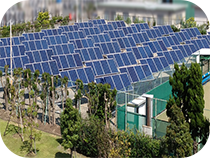The Challenge
There are many opportunities for medium-sized ground-mounted arrays, but the economics on these commercial arrays can be challenging, particularly if the energy cannot be consumed on-site. Without a boost in production, these projects may not generate enough cash flow to justify construction.
Benefits of the RTS
Maximum Energy Yield, Lowest LCOE
The RTS enables developers of all sizes to obtain the high system yield and low Levelized Cost of Energy (LCOE) that previously could only be achieved on large projects. The combination of increased energy yield from optimized tracking, and the highest ground coverage ratio offered by any tracking system results in a maximum total cash flow. The RTS provides the maximum value for these space-constrained systems.
Flexible Design
The standard design block of the RTS is ~378kWp (assuming a typical 15% efficient 300W module), and can be modified for smaller systems as necessary. The flexible array layout can fit into any available project space. The QBotix engineering team can help make sure your system is designed to maximize performance while minimizing cost.
Universal Compatibility
Commercial arrays use a wide range of module types and inverters. The RTS is compatible with all standard system components, including 60-cell and 72-cell crystalline and thin-film modules and all inverters.
Conclusion
The Robotic Tracking System can help arrays of all sizes, shapes, and topographies achieve utility-scale LCOE’s and IRR’s. The flexible size and layout capabilities mean that no space is too small or challenging for the RTS.
